Abstract
Through the Lilly Open Innovation Drug Discovery program (OIDD), we discovered five cationic bis(aryltriazol-4-yl)methyl)-6,7-dimethoxytetrahydroisoquinolinium derivatives that effectively inhibit human nicotinamide N-methyltransferase. Compounds 4a, 4c, and 4f demonstrated activity against hNNMT in enzymatic-based testing, with IC50 values of 3.177 μM, 7.9 μM, and 4.477 μM, respectively. In cell-based testing, 4c and 4f inhibited the enzyme in HEK293 cells with an IC50 value of 2.81 μM and 1.97 μM. Compound 4m inhibited hNNMT in the enzymatic-based assay by 98% at a concentration of 10 μM, with IC50 of 1.011 μM in the cell-based assay. Through structure-activity relationship analysis, we found that the active compounds had electron-withdrawing substituents at the 4-position of the phenyl-triazole, while compounds containing bulky and electron-donating groups at the same position did not display any activity. The results of docking studies using AutoDock 4.2 showed that all active compounds had similar binding patterns at the NNMT active site. They occupied the nicotinamide binding site and about two-thirds of the S-adenosyl-L-methionine site. However, the SAR and docking results of 4g contradicted the compound’s inactivity. Nevertheless, the molecular docking studies provided insight into how the ligands interact with the protein and explained the activity of our compounds.
1. Introduction
Nicotinamide N-methyltransferase (NNMT) enzyme is crucial in detoxification and energy metabolic pathways [1]. It is primarily expressed in the liver and, to a lesser extent, in other organs and adipose tissue [2,3]. NNMT facilitates the transfer of a methyl group from S-adenosyl-L-methionine (SAM), a methyl donor, to nicotinamide (NA), a recipient, resulting in the production of S-adenosyl-L-homocysteine (SAH) and N-methyl-nicotinamide (MNA), as illustrated in Scheme 1.
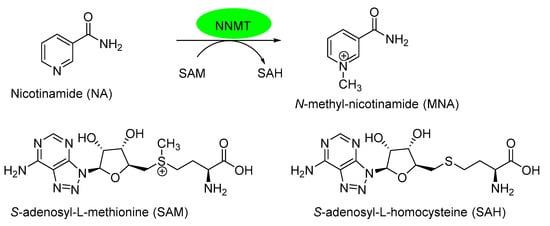
Scheme 1.
Methylation of NA by NNMT using SAM as the methyl donor to form MNA and SAH.
Additional roles of NNMT involve a range of disease status and physiological processes, including Parkinson’s disease [4,5], numerous cancers [6,7,8,9] and metabolic disorders (e.g., Type 2 diabetes) [10,11,12]. Studies in animals and humans have linked the increased NNMT expression and activity in cancer cells with chemotherapy and radiation resistance and increased tumour aggressiveness [13].
Growing evidence suggests that NNMT may serve as a potential biomarker for tumour diagnosis and a new therapeutic target [13,14,15]. Downregulating or silencing NNMT has been shown to increase the sensitivity of cancer cells to radiation therapy, decrease tumorigenicity and induce apoptosis in cancer cells [16]. These findings provide critical support for the role of NNMT in treatment resistance in cancer cells. Therefore, compounds that can inhibit the activity of NNMT may have therapeutic value in cancer treatment. Only a few known NNMT inhibitors have been reported in the literature [17,18,19,20,21,22,23,24].
There is an opportunity to develop novel NNMT inhibitors into molecular probes for mechanistic investigations and for developing therapeutic drugs for treating aggressive cancers in combination or monotherapy. Interestingly, NNMT is also overexpressed in the adipocyte cells of obese and diabetic mice, and overexpression of NNMT mRNA has been found in humans living with insulin-resistant type-2 diabetes (T2D). Therefore, compounds that can inhibit the activity of NNMT in the setting of metabolic pathways may have therapeutic utility in treating obesity and related chronic metabolic diseases [10,11,21]. Gao et al. emphasised the significance of developing cell-active inhibitors for NNMT, highlighting the need for research in this field [23]. In this publication, we report the inhibitory activity of our synthesised cationic bis(aryltriazol-4-yl)methyl)-6,7-dimethoxytetrahydroisoquinolinium compounds [25] against the human NNMT (hNNMT) enzyme as well as a molecular docking study to help explain the structure-activity relationship (SAR) requirements.
2. Materials and Methods
2.1. Biological Assay
Compounds listed in Table 1 (in Section 3.1) underwent screening through the Lilly OIDD program [26] to target hNNMT. The screening process involved primary and secondary assays using a workflow, as shown in Figure S1 of the Supplementary Information.
2.1.1. Primary Assays
hNNMT enzymatic modulation LC/MS assay single point (SP) (% Inhibition) concentration and hNNMT enzymatic modulation LC/MS assay curve respond concentration-response curve (CRC) (IC50) were carried out by OIDD (Lilly Research Laboratories, Eli Lilly and Company, Indianapolis, IN, USA) [26] using a known method developed by van Haren et al. [27]. During the primary assays, the compounds were tested at a concentration of 10 µM using the hNNMT enzymatic modulation assay [27]. Ultra-High Performance (UHP) Hydrophilic Liquid Interaction Chromatography (HILIC) with Quadrupole Time-Of-Flight Mass Spectrometry (QTOF-MS) system was utilised to measure NNMT activity. A mass spectrometric-based detection system was effectively utilised to identify and measure MNA and SAH by-products. An internal standard d3-MNA and a positive control Sinefungin were used. The accuracy and precision of the MNA analysis were established within a range of 0.31–100 μM for both within and between run measurements. The calibration curve’s linearity, sample recovery and detection limit were also confirmed.
2.1.2. Secondary Assays
Compounds 4a, 4c, 4f and 4m underwent hNNMT inhibitor cell-based assay in HEK293 (ATCC-CRL-1573) human hepatoma cell line. The assay was carried out by OIDD (Lilly Research Laboratories, Eli Lilly and Company, Indianapolis, IN, USA) using the method described in the paper by Roberti et al. [28] or Yoshida et al. [24] SAM (Sigma #A7007, St. Louis, MO, USA) and 5 mM NAM (Fluka #72340, Charlotte, North Carolina, NC, USA) or NA-d4 (CDN Isotopes #D-3457) were used as substrates. LC-MS was used to monitor the concentrations of SAM, NA, SAH, and MNA or MNA-d4. Compounds 4a, 4c, and 4f underwent a cell viability assay conducted by OIDD. The data were determined via the percentage cell growth inhibition of basal-HEK293 cells (hNNMT-overexpressing HEK293 cells).
2.1.3. Biological Data
With their permission, the biological data used here were generated and made available through Lilly’s Open Innovation Drug Discovery (OIDD) Program. The OIDD team performed the Analytical Method Validation and Data Analysis, and the provided data are considered statistically valid.
2.2. Molecular Docking Study
2.2.1. Ligands Preparation
To prepare for docking studies, the compounds 4a–n, MvH45, and MS2734 were constructed and optimised using Semi-Empirical (AM1) calculations from the setup menu in Spartan 10 (Wavefunction, Inc., Irvine, CA, USA). Once completed, all files were saved in mol2 format. These compounds were then further prepared using the “Preparing a Ligand for AutoDock” steps found in the “Using AutoDock 4 and Vina with AutoDockTools: A tutorial”—in AutoDock 4.2 with AutoDockTools (ADT, The Scripps Research Institute, San Diego, CA, USA) Version 1.5.7 interface [29]. Finally, each compound was saved in PDBQT format for AutoDock study.
2.2.2. Protein Structure Preparation
The hNNMT crystal structure was obtained in a complex with MS2734 (PDB ID: 6CHH) [19] from the RCSB Protein Data Bank. Before the docking studies, the original inhibitor MS2734 was removed, along with water molecules. Any missing hydrogen atoms were added, and the protein was saved in the pdb file format using Discovery Studio (DS) Visualizer v21.1.0.20298 software (Dassault Systèmes BIOVIA: San Diego, CA, USA, 2020). The protein was further prepared in AutoDock 4.2 using the suggested steps for “Preparing the Macromolecule” [29,30,31]. First, polar-H atoms were added, followed by the addition of Kollman charges. Then, all non-polar hydrogen atoms were merged, and the “AD4 type” forcefield was assigned to atoms in the protein using the ADT “Edit” tool. This optimisation process corrected structural, atomic, and bond length anomalies and charge irregularities. The optimisation step was crucial in ensuring a stable conformation before saving the structure in PDBQT format for docking study.
2.2.3. Preparing Grid Parameters
The grid parameter file was set up for hNNMT (6CHH) and ligand using the recommended steps [29,30,31] in AutoDock 4.2. The active site was chosen as the grid box with 50 × 50 × 50 points in x, y, and z dimensions and a grid box spacing of 0.375 Å. The grid box was centred at the binding coordinate of MS2734, where the x, y, and z centres were set at −8.417, −29.18, and 22.908, respectively. The grid output parameters were saved in a gpf file, which was utilised to run AutoGrid and generate grid glg and map files.
2.2.4. Preparing Docking Parameters
The docking studies were set up following the recommended steps in AutoDock 4.2 [29,30,31]. The macromolecule for docking was selected as “Set Rigid Filename”. The search parameters for docking were set as Genetic Algorithm (GA) with the maximum number of evaluations set to “long” (25,000,000), 10 GA runs, and the remaining parameters were used as defaults. The docking output was saved as a dpf file and then used to run AutoDock. Upon successful completion of the AutoDock run, a results log (dlg file) was generated.
2.2.5. AutoDock Results Analysis
The results of ten genetic algorithm runs (in a dgl file) were analysed and ranked using the Analyze tool in ADT based on binding energy, clustering, and root-mean-square-deviation (rmsd) [29,30,31]. The conformation with the best energy ranking was chosen for further analysis of its protein-ligand interactions and other docking scores. In addition, DS Visualizer software was used to closely analyse the interactions between the inhibitors and the hNNMT binding site.
3. Results and Discussion
3.1. Synthesis of Inhibitors
We previously reported the synthesis of cationic bis(aryltriazol-4-yl)methyl)-6,7-dimethoxytetrahydroisoquinolinium derivatives 4 (Scheme 1) as antibacterial agents [25] using the nitrogen atom of dimethoxytetrahydroisoquinoline 1 to attach the terminal alkyne to produce compound 2. We focused on changing R2 structurally, with the introduction of R2 achieved through the triazole ring formation in the final reaction step between the aromatic azide 3 and alkyne 2. Using Cu-catalyzed azide-alkyne cycloaddition [32,33], we could incorporate various substituted aromatic rings by forming the triazole ring to obtain compounds, as illustrated in Scheme 2 and Table 1.
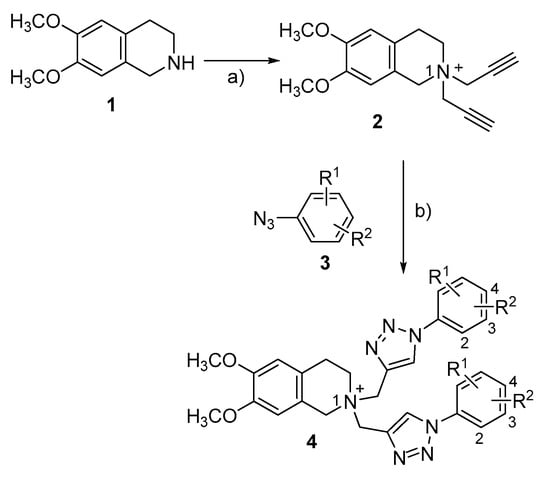
Scheme 2.
Synthesis of cationic bis(aryltriazol-4-yl)methyl)-6,7-dimethoxytetrahydroisoquinolinium 4 a [25]. a Reagents and conditions: (a) Propargyl bromide (3 eq.), K2CO3 (4 eq.), CH3CN, rt, 3 h; (b) aromatic azide 3 (2 eq.), sodium ascorbate (1 eq.), CuSO4.5H2O (0.2 eq.), H2O: i-PrOH (1:1), rt, 24 h.

Table 1.
Compounds 4a–n.
Table 1.
Compounds 4a–n.
| Compound | R1 | R2 |
|---|---|---|
| 4a | H | H |
| 4b | H | 4-tert-butyl |
| 4c | H | 4-CF3 |
| 4d | H | 4-Ph |
| 4e | H | 4-Cl |
| 4f | H | 4-CN |
| 4g | H | 4-NO2 |
| 4h | H | 4-CON(CH3)2 |
| 4i | H | 4-CH=CH-Ph |
| 4j | 3-F | 4-OCH2Ph |
| 4k | 2-F | 4-OCH2Ph |
| 4l | H | 4-CH2OPh |
| 4m | H | 3-CH2OPh |
| 4n | H | 4-CH2SPh |
3.2. Compounds Cheminformatic Evaluation Using OIDD in Silico Screening
The Lilly Open Innovation Drug Discovery (OIDD, Lilly Research Laboratories, Eli Lilly and Company, Indianapolis, USA) [26] program was an initiative by Lilly that encouraged collaboration with researchers globally. This program enabled scientists to use Eli Lilly’s resources to screen new molecules while retaining intellectual property control. Compounds 4a–n in Table 1 were first submitted for a cheminformatic evaluation using the OIDD platform [26]. They were selected for their novelty and drug-like properties based on cheminformatic evaluation. The submitted molecular structures were analysed using filters to select compounds with strong druggable features and eliminate any that may interfere with biological assays during screening. These filters included MW, cLogP, solubility, toxicity, and other physicochemical properties. After undergoing cheminformatic evaluation, the molecules were subject to a substance check and compared with known drugs from both Lilly and PubChem collections. This was done to ensure that only novel compounds were selected. Once the selection was made, the molecules listed in Table 1 were sent to Lilly for a high throughput screening study against key therapeutic targets in the OIDD program. Among the tested targets, our compounds showed inhibitory activity against hNNMT.
3.3. Biological Activities Novel NNMT Inhibitors
Compounds listed in Table 1 underwent screening through the Lilly OIDD program [26] to target hNNMT. The screening process involved primary and secondary assays using a workflow, as shown in Figure S1 of the Supplementary information. The primary assays screened the compounds at a single point (SP) concentration to determine their percentage inhibition (%). Compounds with greater than 50% inhibition were selected for hNNMT enzymatic modulation assay concentration-response curve (CRC, IC50) assay. Compounds with good IC50 values were then tested in secondary assays, which involved determining their inhibitory activity against hNNMT in a cell-based assay and their toxicity in a cell viability assay.
During the primary assays, compounds were tested at a concentration of 10 µM using an hNNMT enzymatic modulation UHP-HILIC-MS assay created by van Hare et al. [27]. The system used a mass spectrometric-based detection system to identify and measure MNAand SAH by-products. An internal standard of d3-MNA and positive control Sinefungin were utilised. The linearity of the calibration curve, sample recovery and detection limit were also verified.
The inhibitory activity of all compounds listed in Table 1 at a concentration of 10 µM is provided in the Supplementary Information Table S1. In the primary assays, 4a, 4c, 4f, 4h, and 4m were found to have inhibition greater than 50% against hNNMT, as noted in Table 2. 4b was able to inhibit the enzyme at a lower percentage of 40%. Following this, 4a, 4c, 4f, and 4h were further tested for their IC50 values in the MNA and SAH concentration-response curves (Table 2). The results obtained from detecting MNA and SAH showed comparable percentages of inhibition and IC50 values. MNA concentration-response curves of tested compounds are shown in Figure 1, and their SAH concentration-response curves are provided in Supplementary information in Figure S2.

Table 2.
Inhibitory activity of compounds 4a, 4b, 4c, 4f, 4h and 4m against hNNMT.
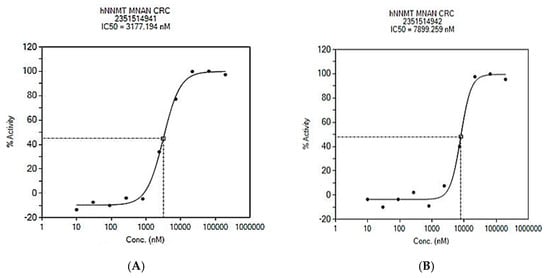
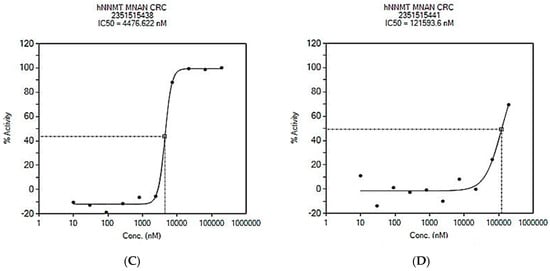
Figure 1.
Concentration-response curve (CRC, IC50) of hNNMT enzymatic modulation using LC/MS assay via monitoring MNA (MNAN) production for (A) 4a, (B) 4c, (C) 4f and (D) 4h. Please note that the OIDD team used the term “MNAN” to refer to “MNA”.
To assess their effectiveness, compounds 4a, 4c, 4f, and 4m underwent the secondary assay in which they were tested for their ability to inhibit hNNMT overexpression in HEK293 cells. The results showed that 4a inhibited the enzyme in HEK293 cells with an IC50 value of 21.75 μM (Figure 2A), indicating that its activity against hNNMT in HEK293 cells was less effective than in the enzymatic-based assay. However, 4c and 4f performed slightly better in the cell-based assay than in the enzymatic-based assay, with IC50 values of 2.81 μM and 1.97 μM, respectively (Figure 2B,C). At a concentration of 10 μM, 4m inhibited hNNMT in the enzymatic-based assay by 98%. Although its IC50 was not determined in the enzymatic-base assay by the OIDD team, a subsequent investigation in the cell-based assay indicated an IC50 of 1.011 μM (Figure 2D).
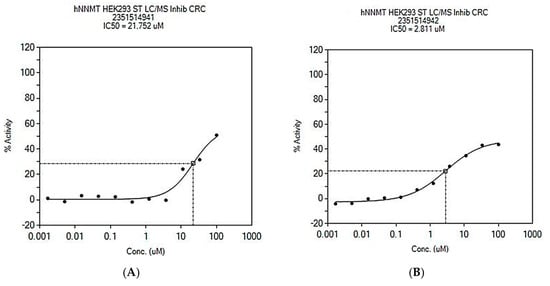
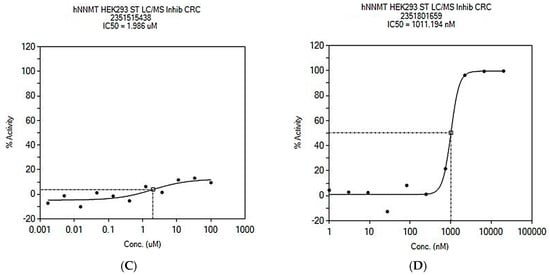
Figure 2.
Inhibitory of hNNMT overexpressed in HEK293 cells, Concentration-response curves (CRC, IC50) of hNNMT enzymatic modulation using LC/MS for (A) 4a, (B) 4c, (C) 4f and (D) 4m.
According to the cell viability assay, compounds 4a, 4c and 4f showed no toxicity towards basal-HEK293 cells, even at the highest test concentration of 100 µM. The percentage growth inhibition observed in basal-HEK293 cells indicated cell viability of approximately 100%, as depicted in Supplementary Figure S3. Based on these results, our lead compounds have the potential for the development of potent and selective hNNMT inhibitors.
3.4. SAR Analysis
Out of the 14 compounds that were tested, five (Table 2) of them showed effectiveness against hNNMT. Among these, 4a, 4c, 4f and 4h have small R2 substituents such as H, CF3, CN, and CON(CH3)2 at the 4-position of the aromatic ring. CF3, CN, and CON(CH3)2 are electron-withdrawing groups. On the other hand, the molecules 4e and 4g, which also contain the electron-withdrawing groups (Cl and NO2), did not show any inhibition of hNNMT. In contrast, compounds 4d, 4i, 4j, 4k, 4l, and 4n have large electron-donating R2 at the 4-position of the aromatic ring and were found to be inactive. It is essential to emphasise that compound 4m is one of the five active compounds. 4m distinguishes itself from the other four active compounds by having R2 as a large electron-donating group (-CH2OPh) in the 3-position of the aromatic ring rather than a small electron-withdrawing group at the 4-th position. Neelakantan et al. [17] conducted a structural activity relationship (SAR) study of nicotinamide-competitive inhibitors and found that the cationic nitrogen group is a crucial pharmacophoric feature. The cationic nitrogen feature perhaps contributes to the activity observed in our compounds. While these results are not comprehensive, they provide some insight into the structural activity relationship (SAR) needed for activity against hNNMT. In order to better understand how our inhibitors interacted with hNNMT and achieved inhibitory activity, we conducted a molecular docking study of our compounds using the published crystal structure of hNNMT (PDB ID: 6CHH) [20] and AutoDock 4.2 software (version 4.2.6) [34].
3.5. Molecular Docking
The published crystal structures of hNNMT can facilitate the rational design of new NNMT inhibitors [19,20,21]. The crystal structures reveal the interactions of the substrates with the active site residues [18]. There are three defined sub-pockets in the NNMT active site: the adenine and sugar unit (pocket A), the homocysteine moiety (pocket B), and the nicotinamide unit (pocket C), as shown in Figure 3. The 2D diagram in Figure 3A illustrates the interactions of NAM and SAM with the protein receptor. The NAM structure binds to pocket C and interacts with ASP197 and SER213, while SAM occupies adjacent pockets B (TYR20 and THR163) and pocket A (Val143 and Asp142).
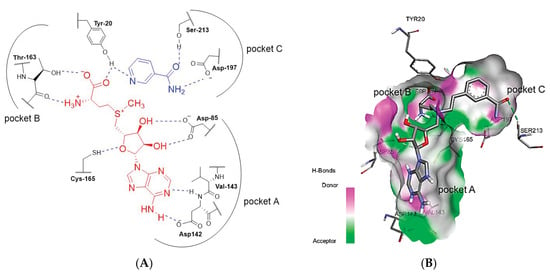
Figure 3.
(A) The active site adapted from the crystal structure of human NNMT [18], (B) showing the bindings of a bisubstrate NNMT inhibitor MS2734 (PDB 6CHH—generated in DSVisualizer), detailed interactions between the inhibitor and the binding pockets’ amino acid residues [20].
The hNNMT crystal structure in complex with the bisubstrate inhibitor MS2734 (PDB ID: 6CHH) [20] offers detailed interactions necessary for inhibition. MS2734 (Figure 4A) is a competitive inhibitor of SAM and a non-competitive inhibitor of NAM, with an IC50 value of 14 µM in enzymatic assay. It binds to both SAM and NAM binding sites. As shown in Figure 3B and Figure 4C, the amino acid side chain binds deeply into pocket B and forms H-bonds with TYR25, TYR69, GLY63, THR163 and THR67 with close contact with SER64 and TYR20. The ribose hydroxyl groups also form hydrogen bonds (H-bonds) with ASP85, ASN90 and CYS165 in the space between pockets B and A. The adenine component of MS2734 sits in pocket A, forms H-bonds with VAL143 and ASP142 and is in close contact with TYR86 and ALA169. The 3-aminophenyl group occupies pocket C and forms H-bonds with SER201 and SER213. It also forms π-π stacking and pi-interactions with LEU164 and TYR204, respectively, and is in close contact with ALA168 and ASP197.
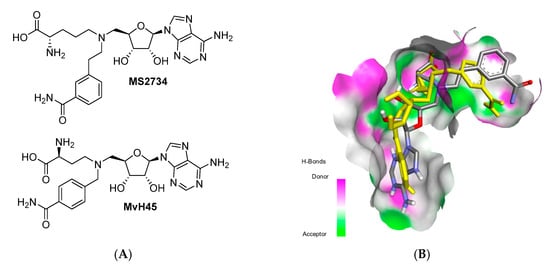
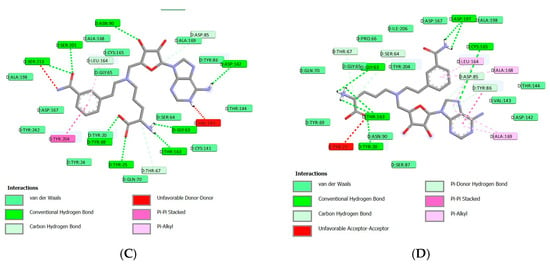
Figure 4.
(A) Bisubstate inhibitors MS2734 and MvH45, (B) 3D diagrams of interaction between best re-docked conf-6 (yellow) and the active site demonstrated by overlapping with MS2734 in the crystal structure (6CHH), (C) 2D ligands-receptor interactions of MS2734 in X-ray structure (6CHH) and (D) 2D ligands-receptor interactions of best re-docked conf-6 at the active site (6CHH).
3.5.1. Docking Method Validation
The crystal structure of hNNMT in complex with the inhibitor MS2734 (PDB ID: 6CHH) [20] was obtained from the RCSB Protein Data Bank. To prepare the protein structure for docking studies, AutoDockTools (Version 1.5.7) [31] and AutoDock 4.2 [34] used the protocol as detailed in the experimental method. To validate the docking protocol, the minimised structure of MS2734 was redocked into its original binding site in the X-ray structure. The results of 10 Genetic Algorithm runs of the redocking were analysed, ranked, and presented in Table 3. The best docking score of MS2734 was achieved by redocked conformation 6 (redocked-conf-6), with a binding energy of −11.29 kcal/mol.

Table 3.
Hydrogen bond interactions between MS2734 and redocked-MS2736 in hNNMT (6CHH).
The position, orientation, conformation, and interactions of the redocked MS2734 were compared to those of the original X-ray structure (PDB ID: 6CHH) at the binding site. It is worth noting that the redocked-conf-6 assumed a slightly different shape in specific parts of the molecule, namely the adenine and sugar unit (pocket A) and nicotinamide unit (pocket C), as depicted in Figure 4B, compared to its structure in the X-ray structure (6CHH). The variation in conformation is perhaps due to the stable conformation of the redocked-conf-6 adopted in silico.
In comparison to MS2734 found in the crystal structure, the redocked-conf-6 established 11 H-bonds with two out of five shared residues in pocket A (CYS165, ASN90), four out of six shared residues in pocket B, and one out of two shared residues in pocket C. The amino acid side chain of the redocked-conf-6 formed H-bonds with TYR20, THR163, GLY63, SER64 and THR67 in pocket B. Within pocket A, the adenine and sugar unit formed H-bonds with CYS165, TYR86 and ASP85 and formed van der Waals interactions with the key residues ASP142 and VAL143. Additionally, the 3-aminophenyl group formed a H-bond with ASP197, pi-interactions with LEU164 and ALA168, and closed interactions with TYR204 in pocket C, as shown in Figure 4D. The shared vital interactions are shown in Table 3. This indicates that the redocked-conf-6 could recognise its original receptor site in the X-ray structure of 6CHH using this docking protocol. The results above validated the docking protocol as a suitable method for this study [35].
MvH45 (Figure 4A) is another bisubstrate hNNMT inhibitor with an IC50 of 29.2 µM [18]. It was used in the docking study as a standard compound, along with MS2734, for comparative study and to confirm our validated method. The docking results reveal that the amino acid side chain of MvH45 bound deeply into pocket B and interacted with critical amino acid residues such as TYR20, THR163 and GLY63. The ribose hydroxyl group formed an H-bond with ASN90, while the adenine nitrogen formed an H-bond with ASP95. It can be inferred from the interactions observed that the adenine unit was bound to the upper region of pocket A (as indicated in Supplementary Table S2). On the other hand, the 3-amidophenyl unit was well-bound in pocket C, which is characterised by its interactions with ASP197, SER213, and TYR204). The docking results of MvH45 further validate the suitability of our docking method (Table 4).

Table 4.
Docking results of compounds 4a–n, MS2734 and MvH45 with the hNNMT (6CHH).
3.5.2. Docking Scores of 4a–n
The validated docking protocol was used to determine compounds 4a–n in silico for their ability to dock into the active site of the hNNMT. The efficacy of inhibition was determined based on the binding energy (kcal/mol) of the compounds, which was expressed as Gibbs-free energy. Compounds with higher negative binding energy were considered better inhibitors [36]. Estimate ligand efficiency and inhibitory constants are also part of the docking score, as shown in Table 4.
The docking scores presented in Table 4 indicate that the active compounds listed in Table 2, including MvH25, have binding energies lower than −11 kcal/mol. However, inactive 4e, 4g, and 4i have binding energies of −13.16, −11.91, and −11.73 kcal/mol, respectively. 4e and 4g have small electron-withdrawing substituents (Cl and NO2) at the 4-position of the aromatic ring. The electron density of these aromatic rings is comparable to that of 4c, 4f, and 4h. Therefore, the effect of pi-interactions, especially with tyrosine residues, would be expected to be similar. The electronic effect of these electron-poor aromatic rings may be the reason behind the low binding energies of 4e and 4g. However, no correlation was found between structure and the low binding energy of the inactive 4i. Analysis of interactions between the compounds at the hNNMT active site can help to explain these anomalies.
3.5.3. Ligand Interactions Analysis
DS Visualizer was used to analyse H-bonds and visualise the binding interactions between hNNMT and compounds 4a–n. The results, including the number of H-bonds, the residues involved in these interactions, and other favourable interactions, are summarised in Table 5 and Supplementary Table S2. The 4-CF3-phenyl-triazolyl part of 4c completely occupied pocket A. The CF3 group formed H-bonds with key amino acid residues VAL143 and ASP142, and the aromatic ring formed H-bond and pi-pi stacking with CYS165 and ASP85, respectively. The triazole ring occupied the sugar-binding pocket and formed H-bonds with ASP85 and GLY63. The dimethoxytetrahydroisoquinolinium (DMTHIQ) core occupied the front part of pocket B. This moiety formed attractive charge interactions with ASP85 and TYR20, with the aromatic ring forming a hydrogen bond with ASN90 and the OCH3 group forming a hydrogen bond with ASN16. However, no hydrogen bonds were observed with the key residues TYR25, TYR69, THR163, and THR67 at the back of pocket B. To illustrate that the DMTHIQ core and a 4-CF3-phenyl-triazolyl component of compound 4c could occupy approximately two-thirds of the SAM binding site, the docking structure of 4c was superimposed over the MS2734 in the crystal structure (6CHH), as shown in Figure 5A. The second 4-CF3-phenyl-triazolyl component of 4c fitted well into pocket C (nicotinamide pocket). The CF3 group formed hydrogen bonds with SER201, while the aromatic and triazole rings formed important pi-pi stacking interactions with TYR204 and TYR242. The triazole ring was also involved in pi-interaction with LEU164, as shown in Figure 5B.

Table 5.
Amino acids involved in the interactions between hNNMT (6CHH) and MS2734, MvH45 and 4a–n, respectively.
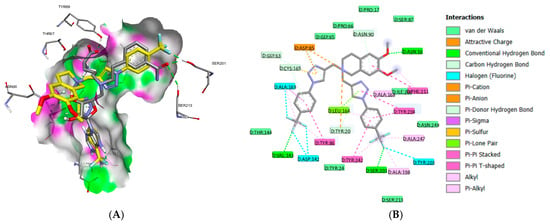
Figure 5.
(A) Structural alignment of 4c (yellow stick) and MS2734 (grey stick) within the active site of NNMT (6CHH), (B) 2D ligands-receptor interactions of 4c at the active site (6CHH).
In their 2021 study, Gao et al. [22] emphasised the effectiveness of electron-deficient aromatic groups in forming pi-pi stacking between hNNMT’s tyrosine residue TYR204 in pocket C. This interaction is required for the potency increase of bisubstate inhibitors. It is worth mentioning that Roberti and colleagues [28] discovered a tetracyclic steroid called CC-410 that is effective against hNNMT, with an IC50 of 1.6 μM. The docking study of CC-410 revealed that it could act as a bisubstrate NNMT inhibitor by binding near the opening of the active site. Part of the molecule filled the NAM pocket, while the remaining part of the molecule partly occupied the SAM pocket.
The docking results revealed that compounds 4a, 4e, 4f, 4g and 4h have similar binding conformation and orientation to that of 4c (Table 5 and Supplementary Table S2). The active compounds 4a, 4c, 4f, and 4h showed hydrogen bonding with important amino acids at NNMT active sites. However, compound 4e was mainly found to bind weakly into pockets A and C. In pocket A, the 4-Cl-phenyl-triazole component formed a H-bond with AS90 and pi-anion interaction with ASN85. Other weaker pi-interactions were also observed between the 4-Cl-phenyl-trizole and TYR86, VAL143, ALA169 and CYS165. The cationic nitrogen of DMTHIQ formed attractive charges with ASP85 and TYR20. The second 4-Cl-phenyl-triazole component formed a H-bond with LEU 167 and π-π stacking with TYR204 and other weak pi-interactions with ALA168, TYR242, ALA198 and TYR242. These weak interactions may explain its inactivity against hNNMT.
In contrast, the inactive compound 4g displayed similar hydrogen bonding interactions and docking scores to those in the active compounds. Compound 4g’s docking results suggest it is an active inhibitor. However, it failed to show inhibition against NNMT, possibly due to bioavailability issues in the primary assay conducted by OIDD. At a concentration of 10 uM, compound 4b could only inhibit 40% of the enzyme activity (Table 5 and Table S2). The compound could partially bind to pockets A and C, leaving pocket B unoccupied. This was due to the sizeable electron-donating tert-butyl group, which created an electron-rich, bulky 4-substituted aromatic ring that could not fit into pocket C. As a result, pocket C was unfavourably occupied by the DMTHIQ core. One of the 4-tert-butyl-phenyl-triazole moieties occupied the top position of pocket A, while the other was bound unfavourably to an undefined pocket located at the front-right side of pocket A. These binding characteristics were also found in compounds 4d, 4i, 4j, 4k, 4l and 4n. These compounds have large electron-donating substituents at the 4-position of phenyl-triazole, making these components too bulky and electron-rich to dock and form favourable interactions with any of the pocket B, C or A. Compounds 4d, 4l, and 4i were found to have intramolecular π-π stacking between their aromatic and triazole rings (Table S2). These interactions caused a decrease in the entropy of the ligand, which resulted in the stabilisation of its binding and a lowering of binding energy. This led to the formation of a compact or folded conformation, which prevented the molecules from interacting with crucial amino acid residues required for NNMT inhibition. This intramolecular interaction and conformation can explain the lower binding energy and inactivity of compound 4i [37]. Moreover, the inactivity of compounds 4d, 4l, and 4i could be attributed to the absence of SAM and NA binding motifs.
Compound 4m has a sizeable electron-donation group at the 3-position of the phenyl-triazole. Based on the docking results, 4m has a binding energy comparable to other active compounds. It also formed intramolecular pi-pi stacking interaction between the two triazole rings and adopted compact conformation. Comparatively, the electron density in the phenyl-triazole group is lower than that of 4d, 4i, 4j, 4k, 4l, and 4n. Due to its bulky R2, 4m could only occupy pockets A and C and form necessary hydrogen bonding interactions with the key amino acid residues at the active site (Table 5 and Table S2).
3.6. Summary of SAR
Molecular docking results provide valuable insights into how our inhibitors interact with hNNMT, resulting in inhibitory activity. The SAR analysis of the active compounds has identified several key chemical features that are required for NNMT inhibition, as summarised in Figure 6. These include (i) the importance of the DMTHIQ core for interacting with ASP85 and AS90, (ii) the crucial role of the positive charge on the N atom of DMTHIQ for interacting with key residues ASP85 and TYR20, (iii) the requirement for R2 (at the 4-position) to be polar, small, and EWG so that it can form H-bonds with crucial amino acids in the C (SER201, SER213, and ASP197) and A (VAL143 and ASP142) pockets, (iv) the need for the phenyl-triazole system to be electron-deficient to form pi-interactions with TYR204 and LEU164 in pocket C and TYR86 in pocket A, and (v) favourable electron-donating group (R2) at the 3-position of the aromatic ring, such as the one observed in 4m, could potentially be beneficial.
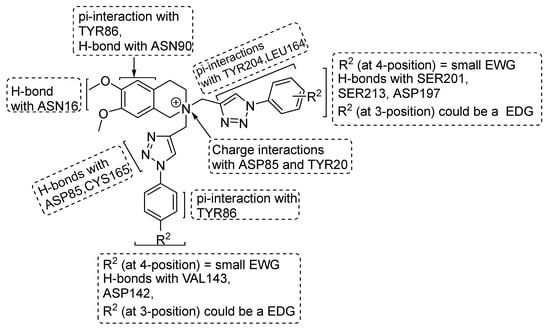
Figure 6.
SAR summary for activecationic bis(aryltriazol-4-yl)methyl)-6,7-dimethoxytetrahydroisoquinoliniumderivatives.
4. Conclusions
The Lilly OIDD program has identified five compounds that effectively inhibit hNNMT. Compounds 4c, 4f and 4m are effective against hNNMT. Compounds 4c, 4f and 4m are effective against hNNMT in both enzyme- and cell-based assays at low micromolar concentrations. Analysis of the SAR and docking study of this small set of molecules revealed that active compounds 4c, 4f and 4h have electron-withdrawing substituents at the 4-position of the aromatic ring. On the other hand, an electron-donating group (R2) at the 3-position of the aromatic ring was found to be beneficial for the activity of compound 4m. Conversely, molecules containing bulky and electron-donating groups at the 4-position of the aromatic ring did not show any activity. All active compounds have similar binding motifs at the NNMT active site. While compound 4g did not show inhibition against NNMT in the primary assay conducted by OIDD, the SAR analysis and docking studies suggest that it should be active. Although the SAR of compound 4g was not clear-cut, the molecular docking studies have provided some insight into the ligand-protein interactions and a plausible explanation for the activity of our compounds. It is crucial to highlight that our findings are preliminary and require further investigation. To achieve a comprehensive SAR, a diverse range of compounds around 4c or 4m needs to be synthesised. Obtaining more comprehensive biological data, including in-vitro pharmacokinetics data of the active compounds, would significantly enhance our understanding of the inhibitory activity of these compounds.
Supplementary Materials
The following supporting information can be downloaded at: https://www.mdpi.com/article/10.3390/appliedchem3040032/s1, Figure S1. Lilly OIDD hNNMT Flow Scheme and Assay Measures; Figure S2. Concentration-response curve (CRC, IC50) of Nicotinamide N-methyltransferase (hNNMT) enzymatic modulation using LC/MS assay via monitoring S-adenosyl-L-homocysteine SAH production; for (A) 4a; (B) 4c; (C) 4f and (D) 4h; Figure S3. Cell viability assay, the percentage growth inhibition of basal-HEK293 cells for (A) compound 4a, (B) compound 4c, and (C) compound 4f; Table S1. Inhibitory activity (%) of compounds 4a–n against human Nicotinamide N-methyltransferase (hNNMT) at 10 µM; Table S2. Interactions between hNNMT (6CHH) and MS2734, MvH45 and 4a–n. Reference [38] is cited in the supplementary materials.
Author Contributions
Conceptualization, A.T.U. and M.P.; methodology, A.T.U. and M.P.; validation, A.T.U.; formal analysis, A.T.U.; investigation, A.T.U. and M.P.; data curation, A.T.U.; writing—original draft preparation, A.T.U.; writing—review and editing, A.T.U. and M.P.; supervision, A.T.U.; project administration, A.T.U. All authors have read and agreed to the published version of the manuscript.
Funding
This research received no external funding.
Institutional Review Board Statement
Not applicable.
Informed Consent Statement
Not applicable.
Data Availability Statement
Data are available within the article.
Acknowledgments
We express our gratitude to the University of Technology of Sydney for their support of this study. Matthew Payne would like to extend appreciation to the Australian Government and the University of Technology Sydney for providing the Research Training Program Stipend. We acknowledge the invaluable contribution of the Lilly Open Innovation Drug Discovery (OIDD) program for screening our compounds. The OIDD screening data was kindly provided by Eli Lilly and Company and used with their permission.
Conflicts of Interest
The authors declare no conflict of interest.
References
- Trammell, S.A.; Brenner, C. NNMT: A bad actor in fat makes good in liver. Cell Metab. 2015, 22, 200–201. [Google Scholar] [CrossRef]
- Aksoy, S.; Szumlanski, C.L.; Weinshilboum, R.M. Human liver nicotinamide N-methyltransferase. cDNA cloning, expression, and biochemical characterization. J. Biol. Chem. 1994, 269, 14835–14840. [Google Scholar] [CrossRef]
- Riederer, M.; Erwa, W.; Zimmermann, R.; Frank, S.; Zechner, R. Adipose tissue as a source of nicotinamide N-methyltransferase and homocysteine. Atherosclerosis 2009, 204, 412–417. [Google Scholar] [CrossRef]
- Parsons, R.B.; Smith, M.-L.; Williams, A.C.; Waring, R.H.; Ramsden, D.B. Expression of nicotinamide N-methyltransferase (EC 2.1. 1.1) in the Parkinsonian brain. J. Neuropathol. Exp. Neurol. 2002, 61, 111–124. [Google Scholar] [CrossRef]
- Williams, A.C.; Ramsden, D.B. Autotoxicity, methylation and a road to the prevention of Parkinson’s disease. J. Clin. Neurosci. 2005, 12, 6–11. [Google Scholar] [CrossRef]
- Sartini, D.; Muzzonigro, G.; Milanese, G.; Pierella, F.; Rossi, V.; Emanuelli, M. Identification of nicotinamide N-methyltransferase as a novel tumor marker for renal clear cell carcinoma. J. Urol. 2006, 176, 2248–2254. [Google Scholar] [CrossRef]
- Pissios, P. Nicotinamide N-methyltransferase: More than a vitamin B3 clearance enzyme. Trends Endocrinol. Metab. 2017, 28, 340–353. [Google Scholar] [CrossRef]
- Ramsden, D.B.; Waring, R.H.; Barlow, D.J.; Parsons, R.B. Nicotinamide N-methyltransferase in health and cancer. J. Tryptophan Res. 2017, 10, 1178646917691739. [Google Scholar]
- Lu, X.; Long, H. Nicotinamide N-methyltransferase as a potential marker for cancer. Neoplasma 2018, 65, 656–663. [Google Scholar] [CrossRef]
- Giuliante, R.; Sartini, D.; Bacchetti, T.; Rocchetti, R.; Klöting, I.; Polidori, C.; Ferretti, G.; Emanuelli, M. Potential involvement of nicotinamide N-methyltransferase in the pathogenesis of metabolic syndrome. Metab. Syndr. Relat. Disord. 2015, 13, 165–170. [Google Scholar] [CrossRef]
- Kraus, D.; Yang, Q.; Kong, D.; Banks, A.S.; Zhang, L.; Rodgers, J.T.; Pirinen, E.; Pulinilkunnil, T.C.; Gong, F.; Wang, Y.-c. Nicotinamide N-methyltransferase knockdown protects against diet-induced obesity. Nature 2014, 508, 258–262. [Google Scholar] [CrossRef]
- Milani, Z.H.; Ramsden, D.B.; Parsons, R.B. Neuroprotective Effects of Nicotinamide N-Methyltransferase and its Metabolite 1-Methylnicotinamide. J. Biochem. Mol. Toxicol. 2013, 27, 451–456. [Google Scholar] [CrossRef]
- Ulanovskaya, O.A.; Zuhl, A.M.; Cravatt, B.F. NNMT promotes epigenetic remodeling in cancer by creating a metabolic methylation sink. Nat. Chem. Biol. 2013, 9, 300–306. [Google Scholar] [CrossRef]
- Chen, C.; Wang, X.; Huang, X.; Yong, H.; Shen, J.; Tang, Q.; Zhu, J.; Ni, J.; Feng, Z. Nicotinamide N-methyltransferase: A potential biomarker for worse prognosis in gastric carcinoma. Am. J. Cancer Res. 2016, 6, 649. [Google Scholar]
- Wang, W.; Yang, C.; Wang, T.; Deng, H. Complex roles of nicotinamide N-methyltransferase in cancer progression. Cell Death Dis. 2022, 13, 267. [Google Scholar] [CrossRef]
- Zhang, J.; Wang, Y.; Li, G.; Yu, H.; Xie, X. Down-regulation of nicotinamide N-methyltransferase induces apoptosis in human breast cancer cells via the mitochondria-mediated pathway. PLoS ONE 2014, 9, e89202. [Google Scholar] [CrossRef]
- Neelakantan, H.; Wang, H.-Y.; Vance, V.; Hommel, J.D.; McHardy, S.F.; Watowich, S.J. Structure–Activity Relationship for Small Molecule Inhibitors of Nicotinamide N-Methyltransferase. J. Med. Chem. 2017, 60, 5015–5028. [Google Scholar] [CrossRef]
- van Haren, M.J.; Taig, R.; Kuppens, J.; Toraño, J.S.; Moret, E.E.; Parsons, R.B.; Sartini, D.; Emanuelli, M.; Martin, N.I. Inhibitors of nicotinamide N-methyltransferase designed to mimic the methylation reaction transition state. Org. Biomol. Chem. 2017, 15, 6656–6667. [Google Scholar] [CrossRef]
- Peng, Y.; Sartini, D.; Pozzi, V.; Wilk, D.; Emanuelli, M.; Yee, V.C. Structural basis of substrate recognition in human nicotinamide N-methyltransferase. Biochemistry 2011, 50, 7800–7808. [Google Scholar] [CrossRef]
- Babault, N.; Allali-Hassani, A.; Li, F.; Fan, J.; Yue, A.; Ju, K.; Liu, F.; Vedadi, M.; Liu, J.; Jin, J. Discovery of bisubstrate inhibitors of nicotinamide N-methyltransferase (NNMT). J. Med. Chem. 2018, 61, 1541–1551. [Google Scholar] [CrossRef]
- Kannt, A.; Rajagopal, S.; Kadnur, S.V.; Suresh, J.; Bhamidipati, R.K.; Swaminathan, S.; Hallur, M.S.; Kristam, R.; Elvert, R.; Czech, J. A small molecule inhibitor of Nicotinamide N-methyltransferase for the treatment of metabolic disorders. Sci. Rep. 2018, 8, 3660. [Google Scholar] [CrossRef]
- Gao, Y.; van Haren, M.J.; Buijs, N.; Innocenti, P.; Zhang, Y.; Sartini, D.; Campagna, R.; Emanuelli, M.; Parsons, R.B.; Jespers, W. Potent inhibition of nicotinamide N-methyltransferase by alkene-linked bisubstrate mimics bearing electron deficient aromatics. J. Med. Chem. 2021, 64, 12938–12963. [Google Scholar] [CrossRef]
- Gao, Y.; Martin, N.I.; van Haren, M.J. Nicotinamide N-methyl transferase (NNMT): An emerging therapeutic target. Drug Discov. Today 2021, 26, 2699–2706. [Google Scholar] [CrossRef]
- Yoshida, S.; Uehara, S.; Kondo, N.; Takahashi, Y.; Yamamoto, S.; Kameda, A.; Kawagoe, S.; Inoue, N.; Yamada, M.; Yoshimura, N. Peptide-to-Small Molecule: A Pharmacophore-Guided Small Molecule Lead Generation Strategy from High-Affinity Macrocyclic Peptides. J. Med. Chem. 2022, 65, 10655–10673. [Google Scholar] [CrossRef]
- Payne, M.; Bottomley, A.L.; Och, A.; Hiscocks, H.G.; Asmara, A.P.; Harry, E.J.; Ung, A.T. Synthesis and biological evaluation of tetrahydroisoquinoline-derived antibacterial compounds. Bioorg. Med. Chem. 2022, 57, 116648. [Google Scholar] [CrossRef]
- Alvim-Gaston, M.; Grese, T.; Mahoui, A.; Palkowitz, A.D.; Pineiro-Nunez, M.; Watson, I. Open Innovation Drug Discovery (OIDD): A potential path to novel therapeutic chemical space. Curr. Top. Med. Chem. 2014, 14, 294–303. [Google Scholar] [CrossRef]
- van Haren, M.J.; Sastre Torano, J.; Sartini, D.; Emanuelli, M.; Parsons, R.B.; Martin, N.I. A rapid and efficient assay for the characterization of substrates and inhibitors of nicotinamide N-methyltransferase. Biochemistry 2016, 55, 5307–5315. [Google Scholar] [CrossRef]
- Roberti, A.; Tejedor, J.R.; Díaz-Moreno, I.; López, V.; Santamarina-Ojeda, P.; Pérez, R.F.; Urdinguio, R.G.; Concellón, C.; Martínez-Chantar, M.L.; Fernández-Morera, J.L. Nicotinamide N-methyltransferase (NNMT) regulates the glucocorticoid signaling pathway during the early phase of adipogenesis. Sci. Rep. 2023, 13, 8293. [Google Scholar] [CrossRef]
- Morris, G.M.; Huey, R.; Lindstrom, W.; Sanner, M.F.; Belew, R.K.; Goodsell, D.S.; Olson, A.J. User Guide, AutoDock Version 4.2, Updated for Version 4.2.6, Automated Docking of Flexible Ligands to Flexible Receptors; The Scripps Research Institute: San Diego, CA, USA, 2014; Volume 6. [Google Scholar]
- Huey, R.; Morris, G.M.; Forli, S. Using AutoDock 4 and Vina with AutoDockTools: A Tutorial; The Scripps Research Institute: San Diego, CA, USA, 2011. [Google Scholar]
- Forli, S.; Huey, R.; Pique, M.E.; Sanner, M.F.; Goodsell, D.S.; Olson, A.J. Computational protein–ligand docking and virtual drug screening with the AutoDock suite. Nat. Protoc. 2016, 11, 905–919. [Google Scholar] [CrossRef]
- Bock, V.D.; Hiemstra, H.; Van Maarseveen, J.H. CuI-catalyzed alkyne–azide “click” cycloadditions from a mechanistic and synthetic perspective. Eur. J. Org. Chem. 2006, 2006, 51–68. [Google Scholar] [CrossRef]
- Worrell, B.; Malik, J.; Fokin, V. Direct evidence of a dinuclear copper intermediate in Cu (I)-catalyzed azide-alkyne cycloadditions. Science 2013, 340, 457–460. [Google Scholar] [CrossRef]
- Morris, G.M.; Huey, R.; Lindstrom, W.; Sanner, M.F.; Belew, R.K.; Goodsell, D.S.; Olson, A.J. AutoDock4 and AutoDockTools4: Automated docking with selective receptor flexibility. J. Comput. Chem. 2009, 30, 2785–2791. [Google Scholar] [CrossRef]
- Rangsinth, P.; Sillapachaiyaporn, C.; Nilkhet, S.; Tencomnao, T.; Ung, A.T.; Chuchawankul, S. Mushroom-derived bioactive compounds potentially serve as the inhibitors of SARS-CoV-2 main protease: An in silico approach. J. Tradit. Complement. Med. 2021, 11, 158–172. [Google Scholar] [CrossRef]
- Gibbs, J.W. A method of geometrical representation of the thermodynamic properties by means of surfaces. In The Collected Works of J. Willard Gibbs, Ph. D., LL. D; Yale University Press: New Haven, CT, USA, 1957; pp. 33–54. [Google Scholar]
- Gao, Y.; Van Haren, M.J.; Moret, E.E.; Rood, J.J.; Sartini, D.; Salvucci, A.; Emanuelli, M.; Craveur, P.; Babault, N.; Jin, J. Bisubstrate inhibitors of nicotinamide N-methyltransferase (NNMT) with enhanced activity. J. Med. Chem. 2019, 62, 6597–6614. [Google Scholar] [CrossRef]
- Sauve, A.A. NAD+ and vitamin B3: From metabolism to therapies. J. Pharmacol. Exp. Ther. 2008, 324, 883–893. [Google Scholar] [CrossRef]
Disclaimer/Publisher’s Note: The statements, opinions and data contained in all publications are solely those of the individual author(s) and contributor(s) and not of MDPI and/or the editor(s). MDPI and/or the editor(s) disclaim responsibility for any injury to people or property resulting from any ideas, methods, instructions or products referred to in the content. |
© 2023 by the authors. Licensee MDPI, Basel, Switzerland. This article is an open access article distributed under the terms and conditions of the Creative Commons Attribution (CC BY) license (https://creativecommons.org/licenses/by/4.0/).